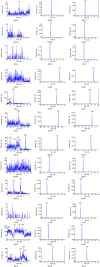Development of a UPLC-MS/MS method for simultaneous therapeutic drug monitoring of anti-hepatocellular carcinoma drugs and analgesics in human plasma
- PMID: 37324468
- PMCID: PMC10264686
- DOI: 10.3389/fphar.2023.1136735
Development of a UPLC-MS/MS method for simultaneous therapeutic drug monitoring of anti-hepatocellular carcinoma drugs and analgesics in human plasma
Abstract
In hepatocellular carcinoma treatment, sorafenib, oxaliplatin, 5-fluorouracil, capecitabine, lenvatinib, and donafenib are first-line drugs; regorafenib, apatinib, and cabozantinib are second-line drugs; and oxycodone, morphine, and fentanyl are commonly used analgesics. However, the high degree of inter- and intra-individual variability in the efficacy and toxicity of these drugs remains an urgent issue. Therapeutic drug monitoring (TDM) is the most reliable technical means for evaluating drug safety and efficacy. Therefore, we developed an ultra-performance liquid chromatography-tandem mass spectrometry (UPLC-MS/MS) method for simultaneous TDM of three chemotherapy drugs (5-fluorouracil, oxaliplatin, and capecitabin), six targeted drugs (sorafenib, donafenib, apatinib, cabozantinib, regorafenib, and lenvatinib), and three analgesics (morphine, fentanyl, and oxycodone). We extracted 12 analytes and isotope internal standards (ISs) from plasma samples by magnetic solid phase extraction (mSPE) and separated them using a ZORBAX Eclipse Plus C18 column with water containing 0.1% formic acid and methanol containing 0.1% formic acid as the mobile phase. The analytical performance of our method in terms of sensitivity, linearity, specificity, carryover, precision, limit of quantification, matrix effect, accuracy, dilution integrity, extraction recovery, stability, and crosstalk of all the analytes under different conditions met all the criteria stipulated by the guidelines of the Chinese Pharmacopoeia and U.S. Food and Drug Administration. The response function was estimated at 10.0-10 000.0 ng/mL for sorafenib, donafenib, apatinib, cabozantinib, regorafenib, and lenvatinib, and 20.0-20 000.0 ng/mL for 5-fluorouracil, oxaliplatin, capecitabin, morphine, fentanyl, and oxycodone, with a correlation of > 0.9956 for all compounds. The precision and accuracy of all analytes were < 7.21% and 5.62%, respectively. Our study provides empirical support for a simple, reliable, specific, and suitable technique for clinical TDM and pharmacokinetics.
Keywords: UPLC-MS/MS; analgesics; chemotherapy and targeted drugs; hepatocellular carcinoma; human plasma; therapeutic drug monitoring.
Copyright © 2023 Lu, Zhao, Zhao and Li.
Conflict of interest statement
The authors declare that the research was conducted in the absence of any commercial or financial relationships that could be construed as a potential conflict of interest. The reviewer YQ declared a shared parent affiliation with the authors to the handling editor at the time of review.
Figures


Similar articles
-
Development and validation of an UPLC-MS/MS method for simultaneous determination of fifteen targeted anti-cancer drugs in human plasma and its application in therapeutic drug monitoring.J Pharm Biomed Anal. 2022 Apr 1;212:114517. doi: 10.1016/j.jpba.2021.114517. Epub 2021 Dec 9. J Pharm Biomed Anal. 2022. PMID: 35131665
-
Ultra-performance liquid chromatography-tandem mass spectrometry for simultaneous determination of 12 anti-tumor drugs in human plasma and its application in therapeutic drug monitoring.J Pharm Biomed Anal. 2021 Nov 30;206:114380. doi: 10.1016/j.jpba.2021.114380. Epub 2021 Sep 20. J Pharm Biomed Anal. 2021. PMID: 34607204
-
Quantification of sorafenib, lenvatinib, and apatinib in human plasma for therapeutic drug monitoring by UPLC-MS/MS.J Pharm Biomed Anal. 2021 Aug 5;202:114161. doi: 10.1016/j.jpba.2021.114161. Epub 2021 May 21. J Pharm Biomed Anal. 2021. PMID: 34052550
-
Development and clinical validation of a simple and fast UPLC-ESI-MS/MS method for simultaneous quantification of nine kinase inhibitors and two antiandrogen drugs in human plasma: Interest for their therapeutic drug monitoring.J Pharm Biomed Anal. 2021 Apr 15;197:113968. doi: 10.1016/j.jpba.2021.113968. Epub 2021 Feb 14. J Pharm Biomed Anal. 2021. PMID: 33618135
-
Rapid Determination of 9 Tyrosine Kinase Inhibitors for the Treatment of Hepatocellular Carcinoma in Human Plasma by QuEChERS-UPLC-MS/MS.Front Pharmacol. 2022 Jun 21;13:920436. doi: 10.3389/fphar.2022.920436. eCollection 2022. Front Pharmacol. 2022. PMID: 35800447 Free PMC article.
Cited by
-
Pharmacokinetics of Anti-rheumatic Drugs Methotrexate and Tofacitinib with its Metabolite M9 in Rats by UPLC-MS/MS.Curr Med Chem. 2024;31(22):3426-3435. doi: 10.2174/0109298673256258231219060950. Curr Med Chem. 2024. PMID: 38310397
-
Determination of Pralsetinib in Human Plasma and Cerebrospinal Fluid for Therapeutic Drug Monitoring by Ultra-performance Liquid Chromatography-Tandem Mass Spectrometry (UPLC-MS/MS).Anticancer Agents Med Chem. 2024;24(11):867-877. doi: 10.2174/0118715206290110240326071909. Anticancer Agents Med Chem. 2024. PMID: 38584556
References
-
- Fan J., Qin S. K., Cai X. J., Zhou J., Shen F., Wang W. L. (2022). Guidelines of Chinese Society of Clinical Oncology (CSCO). Hepatocellular carcinoma.
LinkOut - more resources
Full Text Sources
Miscellaneous

